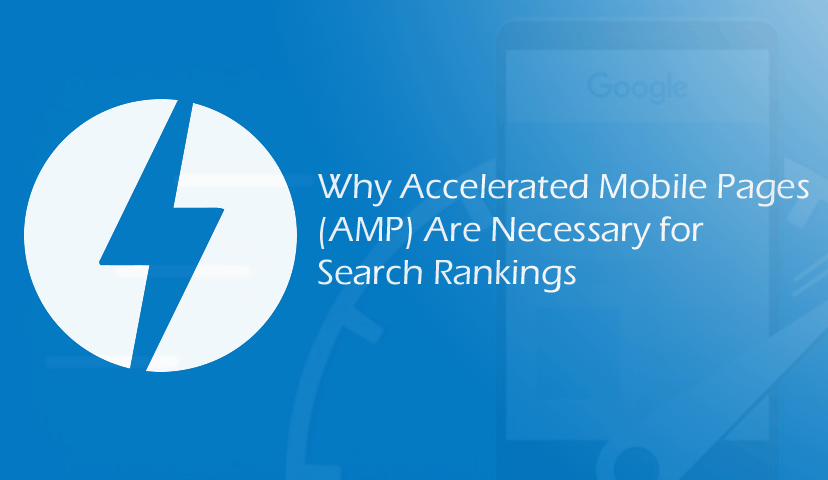Why Accelerated Mobile Pages (AMP) Are Necessary for Search Rankings

What is the timeframe a user is prepared to wait for your webpage to load? According to research, roughly 40 percent of online users won’t tolerate a delay that exceeds the time it takes for you to read this line. They’ll stick around for just three seconds before choosing to exit your site and switch to another one. This is precisely the issue AMP aims to solve.
AMP stands for Accelerated Mobile Pages and its aim is to make the internet fast for people using mobile devices.
While there are benefits to AMP, including the potential of better search rankings, the technology has its critics.
In addition, while most businesses now insist on mobile-friendly website design when getting their website developed, AMP is an additional step not many have taken. It’s used extensively by news publishers, but beyond that the prevalence of AMP is limited.
That said, it’s a topic you should know more about, however, particularly in relation to mobile SEO.
What Is AMP?
AMP is an open source publishing technology created by Google. It is used by website developers to create website pages for mobile devices.
In practice, AMP strips away a lot of elements and coding that are part of standard website pages. The aim is to make the page load as fast as possible. So, a webpage developed using AMP still uses HTML, but it’s a subset of HTML. AMP also has a JavaScript library, although it’s a library optimized for speed.
Finally, webpages built using AMP also use Google AMP Cache. This is a CDN (Content Delivery Network) that caches website pages. This caching, along with the stripped-down nature of the page, makes the page load almost instantly.
Benefits of AMP
When considering the benefits of AMP, it’s important to look at the benefits of the technology for Google and for users to your website as well as the benefits to your business. Doing this will help you understand why Google continues to invest in, develop, and improve AMP even though the take-up so far falls well short of it being widespread.
For users of websites, they benefit from faster loading website pages. Almost all research shows this is what users want.
Google benefits too as its main goal with its search tool is to provide users with the answer to their query as quickly as possible.
In other words, Google regards it as a poor reflection on the quality of its service if a person using Google search on a mobile device clicks on a result and then abandons the website after a few seconds because it took too long to load.
When this happens, Google has failed in its quest to provide its users with the answers they need as quickly as possible.
What about the benefits of AMP to your website and business, though? There are three main benefits you should be aware of.
Faster Loading Pages
While page load speed is only one aspect of UX (User Experience), it’s an important one. So, having website pages that load faster because of AMP technology will benefit your business.
Increased Click Through Rates
Google displays a small icon on its mobile search results pages beside each result that uses AMP technology. The symbol is a small grey circle with a white lighting flash bolt inside.
This indicates to mobile search users the page loads fast.
Internet users are becoming more aware of what this symbol means and may be more likely to click on results with the symbol than results that don’t.
Potentially a Ranking Factor
While this hasn’t been confirmed by Google, many SEO experts and analysts believe that AMP became a ranking factor after Google switched to mobile first indexing.
The Downsides of AMP
As with most things in business, there are downsides to AMP as well as benefits. It’s important you understand the downsides before making a decision.
Most of the individual downsides of AMP fall under the umbrella of the restrictive nature of the technology. In other words, there is a lot more you can’t do with an AMP webpage than you can do.
For example, when it first launched, you could not have ads on a website page built using AMP. You can now as new features have been added, but you are still restricted to just one.
As an SME, you might not have any interest in running ads on your website, but this example does illustrate the restrictions you’ll face when using AMP. Those restrictions could impact user experience and, in the worst-case scenario, impact your conversion rate.
One final point on the downsides of AMP is the fact that none of them are absolute. In fact, with a professional SEO service by an experienced SEO provider, most of the downsides often mentioned in relation to AMP can be mitigated.
AMP for Search Rankings – the Final Say
In many cases, the final decision on whether to implement AMP comes down to search rankings. Even if AMP is not used by Google as a direct ranking factor and will not help to get your site on the first page of google, but the page load speed is considered by its search algorithm, as is click through rate.
For these reasons alone, AMP is something you should explore further.





